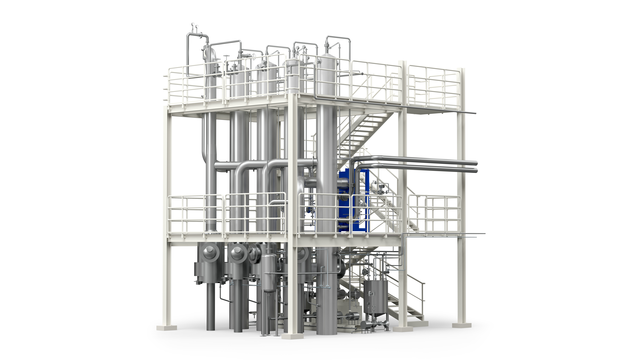FilmVap
Alfa Laval FilmVap tubular falling-film evaporators are well proven and mechanically reliable. An innovative arrangement featuring more efficient vapour separators ensures a smaller footprint than with other falling-film designs. These evaporators can process clear, non-fouling liquids as well as moderately fouling liquids, as a result of optimally configured FilmVap liquid distributors.
Liquid distribution, the key element
The liquid distributor is the most critical component in any falling-film evaporator. The optimized design of the liquid distributor helps prolong uptime and reduce CIP costs. It also reduces any additional effluent generation stemming from CIP, as well as the treatment costs involved.
Platter distributor
The combination of uniform distribution of liquid in a platter distributor and adequate wetting helps to avoid inefficient distribution and significantly reduces fouling in the tubes. The vent tubes maintain pressure equilibrium above and below the distributor plate as well as maintaining a consistent static weight of liquid on the distribution plate.
Jet distributor
 Another type of liquid distributor available in Alfa Laval FilmVap evaporators is the jet distributor, fitted with solid cone spray nozzles. The size and quantity of these nozzles depend on the liquid flow and the tube sheet diameter in the heat exchanger. The larger hole size compared with a platter distributor reduces the risk of blocking the nozzle and ensures even distribution to the tubes.
Another type of liquid distributor available in Alfa Laval FilmVap evaporators is the jet distributor, fitted with solid cone spray nozzles. The size and quantity of these nozzles depend on the liquid flow and the tube sheet diameter in the heat exchanger. The larger hole size compared with a platter distributor reduces the risk of blocking the nozzle and ensures even distribution to the tubes.
Vorteile
- Kleine Stellfläche
- Hervorragende Verteilung
- Zuverlässig und robust
So funktioniert es.

Die FilmVap-Verdampfungssysteme von Alfa Laval basieren auf dem Prinzip des rohrförmigen Fallfilms. Das Produkt wird am oberen Ende des Verdampfers zugeführt. Über ein Flüssigkeitsverteilungssystem gelangt das Produkt in die Rohre, wo es an der Innenwand einen Film bildet.
An der Außenseite der Rohre wird Dampf als Wärmequelle zugeführt. Beim Sieden fällt der Film unter der Schwerkraft und beschleunigt durch den erzeugten Dampf auf den Boden der Röhre, wo das Gemisch aus Dampf und konzentriertem Produkt in die Trennstufe gelangt.
Im FilmVap-System wird ein Vakuum angelegt, um die Siedetemperatur zu senken. Das Vakuum wird durch Kondensation des Dampfes aus dem letzten Effekt in einem Kondensator erzeugt, z. B. dem hocheffizienten und kompakten AlfaCond-Kondensator. Eine Vakuumpumpe wird normalerweise verwendet, um die nicht kondensierbaren Gase zu entfernen.
Durch die Konstruktion mit mehreren Effekten wird der Dampfverbrauch in Verdampfungssystemen reduziert: Der in einem Effekt erzeugte Dampf wird als Heizmedium im nachfolgenden Effekt verwendet. In Kombination mit thermischer Brüdenkompression und/oder mechanischer Brüdenkompression kann der Dampfverbrauch auf einen Bruchteil der Verdampfungsleistung reduziert werden.

